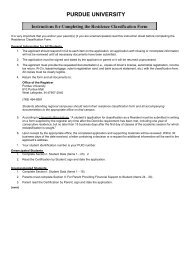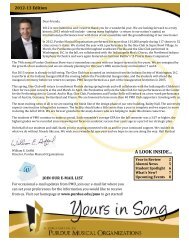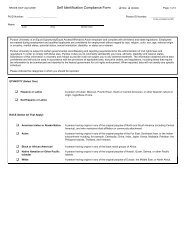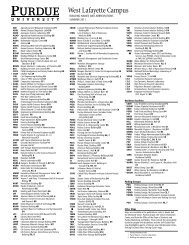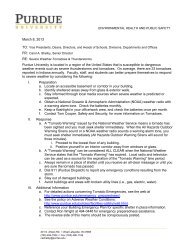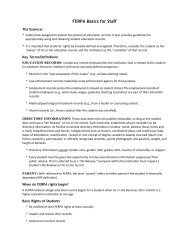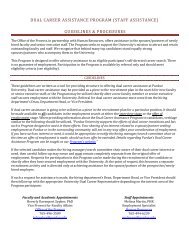Retire Smart Benefit Options - Purdue University
Retire Smart Benefit Options - Purdue University
Retire Smart Benefit Options - Purdue University
You also want an ePaper? Increase the reach of your titles
YUMPU automatically turns print PDFs into web optimized ePapers that Google loves.
RETIRE SMART<br />
<strong>Benefit</strong> <strong>Options</strong><br />
…for <strong>Purdue</strong> <strong>Retire</strong>es
RETIRE SMART<br />
Thank you for your dedicated service and your<br />
help in making <strong>Purdue</strong> a great place to learn and<br />
work. We appreciate your efforts and the valuable<br />
contributions that you have made to the continued<br />
success of the <strong>University</strong>. As you begin to make<br />
your retirement plans, we want to do everything<br />
possible to assist in your transition to retirement.<br />
2<br />
Who Qualifies as an Official <strong>Retire</strong>e?<br />
You qualify to be an Official <strong>Retire</strong>e if you meet the<br />
requirements outlined in any of the categories below.<br />
A faculty or staff member age 55 or more:<br />
1. Who was employed by <strong>Purdue</strong> <strong>University</strong> in a<br />
benefits‐eligible position for 10 or more years and<br />
2. Whose age plus years of <strong>Purdue</strong> employment<br />
equaled or exceeded 70 at time of retirement.<br />
Or<br />
A faculty or staff member who:<br />
1. Participated in one of the <strong>University</strong> retirement<br />
plans (Defined Contribution Plan, Public Employees’<br />
<strong>Retire</strong>ment Fund, or Civil Service), and<br />
2. Received benefits under the <strong>University</strong>’s long‐term<br />
disability program (LTD) until the age or scheduled<br />
benefit limit at which LTD benefits terminated, and<br />
3. Was continuously employed with the <strong>University</strong> for<br />
five years or more prior to qualifying for LTD.<br />
Or<br />
The surviving spouse and surviving children of a person who:<br />
1. Was a <strong>Purdue</strong> employee at the time of his or her death and<br />
2. Had been continuously employed by the <strong>University</strong><br />
for five of more years immediately prior to death.<br />
Or<br />
The surviving spouse and surviving children of a person<br />
who was an official retiree of the <strong>University</strong>.<br />
Additionally, to be considered “qualifying” under the policy,<br />
surviving children must meet the requirements necessary to<br />
qualify as a dependent under the <strong>University</strong>’s medical plan.<br />
Official <strong>Retire</strong>e Privileges<br />
<strong>Purdue</strong> <strong>University</strong> grants a variety of<br />
privileges to official retirees. The list<br />
below highlights some of them. For<br />
additional information, visit<br />
www.purdue.edu/retirees.<br />
<strong>Purdue</strong> faculty/staff photo<br />
identification card. <strong>Retire</strong>es<br />
may obtain the card at the Card<br />
Services office, Room 130, <strong>Purdue</strong><br />
Memorial Union. The card will<br />
facilitate access to computer<br />
services, recreational facilities, sports<br />
events, cultural events, <strong>University</strong><br />
Libraries, CityBus service, and the<br />
<strong>Purdue</strong> discount programs offered<br />
by local businesses. (Surviving<br />
spouses are eligible for an ID card.)<br />
Discounts on event tickets.<br />
<strong>Purdue</strong> retirees may purchase<br />
tickets at staff rates to attend<br />
convocations, lectures, and<br />
athletic events. The discounts<br />
are applicable for retirees, their<br />
spouses, and dependent children.<br />
Staff rates. <strong>Purdue</strong> retirees can use<br />
<strong>University</strong> recreational facilities and<br />
golf courses at special reduced rates.<br />
Free issues of the PURA<br />
Newsletter from the <strong>Purdue</strong><br />
<strong>University</strong> <strong>Retire</strong>es Association.<br />
Special announcements are<br />
mailed or e‐mailed as needed.
A copy of the <strong>Purdue</strong> Telephone<br />
Directory. The directory includes<br />
an address, phone information, and<br />
former department for each retiree.<br />
Complimentary “A” parking<br />
permit. Permits for retirees are<br />
available at Parking Facilities in<br />
the Visitor Information Center. For<br />
information, call 765‐494‐9494.<br />
Medical plan participation.<br />
Optional participation in a<br />
<strong>University</strong>‐supported medical plan<br />
(if you are under 65) or Medicare<br />
supplemental plan (if you are<br />
65 or over).<br />
Use of the <strong>Purdue</strong> <strong>University</strong><br />
Pharmacy. The pharmacy is located<br />
in the Robert E. Heine Pharmacy<br />
Building (RHPH), Room 118<br />
(adjacent to the Student Health<br />
Center). Licensed pharmacists,<br />
graduate student instructors,<br />
and pharmacy students staff the<br />
pharmacy, which accepts the<br />
PURcare prescription drug plan<br />
as well as <strong>Purdue</strong> drug plans for<br />
retirees under 65. Payment must<br />
be made at the time of purchase<br />
by cash, check, or credit card.<br />
Services at the Nursing Center<br />
for Family Health. During the<br />
academic year, retirees have access<br />
to free health screenings and to<br />
services for a fee, such as physical<br />
exams, blood pressure monitoring,<br />
glucose screening, and cholesterol<br />
tests. Information about free flu<br />
shots is available by calling WorkLife<br />
Programs in Human Resources<br />
at 765‐494‐5461. Additional<br />
information is available by calling the<br />
Nursing Center at 765‐494‐6341.<br />
<strong>Purdue</strong> discount programs<br />
offered locally. <strong>Retire</strong>es can<br />
take advantage of discounts<br />
for a variety of services and<br />
items. For more information, call<br />
765‐494‐7383 or visit www.purdue.<br />
edu/cssac/Employee_Discounts.<br />
Computers. <strong>Retire</strong>es can contact<br />
ITaP for discounts on computers<br />
and peripherals from Apple, Dell,<br />
HP, and others. To view the latest<br />
computer models, stop by ITaP<br />
Shopping Offline Vendor Showcase<br />
located in Stewart Center, Room<br />
G‐65. Call 765‐494‐4000.<br />
Use of <strong>University</strong> e‐mail and data<br />
network remote facilities. All<br />
official retirees are eligible to use the<br />
<strong>University</strong>’s electronic mail services.<br />
Fee privileges. <strong>Retire</strong>d faculty and<br />
staff and their qualified children<br />
have the same privileges for class<br />
enrollments as current faculty and<br />
staff. Information about enrolling in<br />
classes is available through the Office<br />
of Admissions, 765‐494‐1776, and<br />
information about fees is available<br />
through the Office of the Bursar,<br />
765‐494‐7570. Identify yourself<br />
as a <strong>Purdue</strong> retiree. Free tuition is<br />
also available for qualifying Indiana<br />
residents age 60 and older through<br />
the Ivy Tech Community College<br />
Senior Scholars program. For details<br />
about taking credit courses for<br />
letter grades, contact the Ivy Tech<br />
Admissions Office at 765‐269‐5200.<br />
Free rides on CityBus. With the<br />
<strong>Purdue</strong> faculty/staff/retiree ID,<br />
retirees can ride the CityBus routes<br />
throughout the Lafayette‐West<br />
Lafayette area, including the<br />
Campus Loop routes. CityBus<br />
schedules and maps are available<br />
at the <strong>Purdue</strong> Visitor Information<br />
Center in the Northwestern<br />
Avenue Parking Garage and at the<br />
CityBus office within the Riehle<br />
Depot in downtown Lafayette.<br />
Employee Assistance Program<br />
(EAP). EAP provides a free<br />
confidential and professional service<br />
to help <strong>Purdue</strong> retirees and family<br />
members resolve personal problems.<br />
The office is located at<br />
1601 W. State Street, West<br />
Lafayette. For more information,<br />
call 765‐494‐7707.<br />
<strong>Purdue</strong> <strong>University</strong> Libraries.<br />
<strong>Retire</strong>es have access to<br />
the wide‐ranging <strong>Purdue</strong><br />
<strong>University</strong> Libraries facilities.<br />
3
<strong>Purdue</strong> <strong>University</strong> <strong>Retire</strong>es Association (PURA)<br />
An official retiree of <strong>Purdue</strong> <strong>University</strong> automatically becomes a member of the <strong>Purdue</strong> <strong>University</strong> <strong>Retire</strong>es<br />
Association (PURA). PURA offers many opportunities to participate in continuing education and social<br />
programs. It offers help in meeting the challenges of retirement and in sharing views with others who<br />
have similar concerns. And best of all, it offers the advantages of membership with no dues.<br />
The PURA executive board and committees work to improve the state of and opportunities for retirees. Regular<br />
attention is given to medical insurance, financial planning, and other quality‐of‐life issues. The association also<br />
encourages volunteer opportunities on campus and in the community and keeps you informed of campus news. The<br />
continuing and primary goal of PURA is to help you enjoy a stimulating, involved, productive, and happy retirement.<br />
We encourage you to make frequent use of the PURA website: www.purdue.edu/retirees.<br />
4<br />
A Message About<br />
PURcare and<br />
Its Advantages<br />
from the <strong>Purdue</strong><br />
<strong>University</strong> <strong>Retire</strong>es<br />
Association<br />
The future of medical insurance<br />
is very much unknown. But no<br />
matter what changes occur,<br />
<strong>Purdue</strong> retirees serving on the<br />
<strong>Benefit</strong>s Committee of the <strong>Purdue</strong><br />
<strong>University</strong> <strong>Retire</strong>es Association<br />
(PURA) will work hard to provide<br />
the best supplemental medical/drug<br />
insurance program for <strong>Purdue</strong><br />
retirees through the PURcare plan.<br />
The PURcare plan offers these<br />
advantages for <strong>Purdue</strong> retirees:<br />
• PURcare has a <strong>Purdue</strong> staff<br />
member assigned full‐time to<br />
provide assistance and support<br />
for members should they have<br />
insurance problems or questions.<br />
• New <strong>Purdue</strong> retirees cannot be<br />
denied coverage in PURcare<br />
because of pre‐existing conditions.<br />
• PURcare provides dependable<br />
and affordable coverage that<br />
is not age or gender‐rated,<br />
as are most private plans.<br />
• Participating in PURcare is<br />
one way to maintain a link<br />
to <strong>Purdue</strong> after retirement.<br />
• All official <strong>Purdue</strong> retirees and<br />
their eligible dependents who<br />
are 65 years old and enrolled<br />
in Medicare Parts A and B<br />
are eligible for the PURcare<br />
(or the Medicare Advantage<br />
PPO) insurance pool.<br />
o Some retirees have employed<br />
spouses who cover the retiree<br />
on their employer’s health<br />
plan, so a retiree may be well<br />
beyond age 65 when first<br />
eligible to join PURcare.<br />
o <strong>Purdue</strong> retirees and spouses<br />
who retire prior to age 65<br />
are eligible to participate in<br />
the <strong>Purdue</strong> <strong>University</strong> active<br />
employee health care plan<br />
until they reach the age of 65<br />
and are eligible for PURcare.<br />
• PURcare participants do not<br />
need to re‐enroll each year. It<br />
happens automatically, unless<br />
they choose to stop participating.<br />
• The larger the population in<br />
the insurance pool, the wider<br />
the risk is spread. This benefits<br />
everyone in PURcare. Healthy<br />
people subsidize the people<br />
with more health problems:<br />
o As people grow older,<br />
they tend to have more<br />
health problems.<br />
o Healthy people cannot<br />
opt‐out of PURcare and<br />
then opt‐in when they<br />
develop health problems.<br />
That is not fair to those who<br />
have been in the program<br />
from the beginning.<br />
Health Care <strong>Options</strong><br />
for <strong>Retire</strong>es Age<br />
65 and Over<br />
<strong>Purdue</strong> <strong>University</strong> currently<br />
sponsors two health plans for<br />
eligible <strong>Purdue</strong> <strong>University</strong> retirees.<br />
The plans are structured and<br />
administered differently, but they<br />
are both group plans designed<br />
specifically for <strong>Purdue</strong> retirees.<br />
While each plan has distinct<br />
advantages, the most important<br />
consideration when choosing a plan<br />
is how well it suits you. Think about<br />
your current health care needs as<br />
well as those you see down the<br />
road. Both plans cover Medicare<br />
services and supplies, plus they offer<br />
coverage for added medications<br />
and certain other types of care.<br />
The differences come when you<br />
look at how much you are likely to<br />
spend out of your own pocket during<br />
the year – for monthly premiums<br />
to participate in a plan as well as<br />
copayments (copays), plan deductibles,<br />
and coinsurance when you need care.<br />
To help you understand the<br />
differences between the two plans:<br />
Read the sections that follow, and<br />
review the examples in this booklet<br />
Review your enrollment materials.<br />
Contact a <strong>Purdue</strong> Human Resources<br />
(HR) Customer Service representative<br />
at 765‐494‐2222 or e‐mail<br />
hr@purdue.edu,<br />
if you have questions.
<strong>Retire</strong>es Under Age 65<br />
If you are under age 65, you are offered<br />
the same medical plans available to <strong>Purdue</strong><br />
faculty and staff. Refer to the separate sheet<br />
showing options and their costs.<br />
About Plan 1: PURcare<br />
While Medicare becomes the primary<br />
health insurance coverage for retirees<br />
age 65 and older, it doesn’t cover<br />
everything. So, <strong>Purdue</strong> <strong>University</strong><br />
offers this plan to retirees – called<br />
a Senior Supplement plan with<br />
prescription drug (Rx) coverage that<br />
complies with Medicare Part D – as a<br />
way to fill in the gaps.<br />
Plan 1 assumes that you are enrolled in<br />
Medicare Parts A and B and are paying<br />
the required Medicare Part B premium<br />
through automatic deductions<br />
from your Social Security check.<br />
When you elect this plan, you pay a<br />
monthly premium to the insurance<br />
company for enhanced coverage. By<br />
combining coverage under this plan<br />
with Medicare, you are 100% covered<br />
for most services and supplies you<br />
will need. To learn more about your<br />
premiums under this plan, refer to<br />
the summary of benefits on page 6.<br />
When you need care, you can see any<br />
doctor or use any service that accepts<br />
Medicare for medically necessary<br />
care. Under this plan, claims are first<br />
processed through Medicare. Then, the<br />
insurance company reviews the claim<br />
and, in most cases, provides added<br />
benefits according to provisions and<br />
features of Plan 1. That means that<br />
you will get two separate Explanations<br />
of <strong>Benefit</strong>s (EOBs) – one quarterly<br />
from Medicare and a separate one<br />
from the insurance company.<br />
With the exception of vision benefits,<br />
before medical coverage begins, you<br />
must satisfy an individual yearly<br />
deductible of $300. The deductible<br />
will be applied as appropriate toward<br />
the Medicare deductibles for Parts A<br />
and B until you have paid a total of<br />
$300. The remainder of the Medicare<br />
deductible amounts will be paid<br />
by the plan. Once the deductible<br />
is met, all other Medicare eligible<br />
medical expenses for that individual<br />
are covered for the rest of the year.<br />
A yearly “wellness“ visit and<br />
certain preventive tests are<br />
covered 100 percent by Medicare.<br />
No deductible applies.<br />
There is no deductible for Rx.<br />
See “Plan 1 Prescription Drug<br />
<strong>Benefit</strong>s” to learn about how<br />
prescription drugs are covered.<br />
5<br />
About Plan 2: Medicare Advantage PPO<br />
Not available to residents of Dekalb,<br />
Gibson, Morgan, Shelby and Warren<br />
counties. Plan 2 is a Medicare Part C<br />
(Medicare Advantage) plan that has<br />
been created for <strong>Purdue</strong> retirees. It<br />
includes a Medicare Part D prescription<br />
drug benefit. Plan 2 offers a lower<br />
monthly premium than Plan 1,<br />
which means you will pay less on a<br />
monthly basis in exchange for higher<br />
out‐of‐pocket costs when you need<br />
care. There is no annual deductible,<br />
but there are copays and coinsurance<br />
that you will be responsible for during<br />
the year. Under this plan, you have<br />
more financial risk if you need care<br />
during the year, because you will have<br />
to pay a portion of the cost at that<br />
time through copays and coinsurance.<br />
The plan assumes that you are<br />
enrolled in Medicare Parts A and B<br />
and are paying the required Medicare<br />
Part B premium automatically from<br />
your Social Security check. When<br />
you elect this plan, you pay a<br />
monthly premium to the insurance<br />
company for enhanced coverage.<br />
To learn more about your premiums<br />
under the plans, refer to the<br />
summary of benefits on page 6.<br />
Since this is a Medicare Advantage<br />
plan, claims are processed directly<br />
through the insurance company<br />
– rather than first through Medicare<br />
and then through the insurance<br />
company. Plan 2 takes into account<br />
what Medicare would have paid<br />
toward a covered service or supply and<br />
then coordinates benefits behind the<br />
scenes. That means that you will get<br />
only one Explanation of <strong>Benefit</strong>s (EOB),<br />
directly from the insurance company,<br />
stating how much was paid to the<br />
provider and what is left for you to pay.<br />
A preventive care feature under<br />
this plan provides a 100% benefit<br />
for the cost of an annual physical<br />
exam – with no office visit copay<br />
required. See “Plan 2 Prescription<br />
Drug <strong>Benefit</strong>s” to learn about how<br />
prescription drugs are covered.
Understanding Medicare<br />
Medicare is the federal government’s principal health care insurance program for individuals<br />
age 65 and over. In general, Medicare pays for “acute” care, which is care that the program’s<br />
administrators view as reasonable and necessary to diagnose or treat an illness or injury.<br />
For purposes of your plan election, it is important for you to understand the following four Medicare parts:<br />
Medicare Part A (hospital insurance) covers inpatient hospital expenses and has a per hospitalization deductible<br />
Medicare Part B (medical insurance) covers medical expenses (doctor’s office<br />
and outpatient expenses) and has an annual deductible<br />
Medicare Part C (Medicare Advantage) plans offer people with Medicare Parts A and B the option of receiving all<br />
of their health care services through a private health insurance company instead of directly through Medicare<br />
Medicare Part D (prescription drug plan) is a Medicare benefit (administered by insurance companies)<br />
that offers a choice of prescription drug plans to anyone enrolled in Medicare Part A and Part B.<br />
Summary of <strong>Benefit</strong>s<br />
Review the chart below to see how the plans compare and how much each plan would cost you in 2012.<br />
6<br />
PLAN COMPARISONS<br />
The Plan Pays – Toward Covered Charges<br />
FEATURE PLAN 1 ‐ PURcare PLAN 2 ‐ Medicare Advantage PPO<br />
Preventive care<br />
(Coverage for yearly “wellness“ visit)<br />
Covered 100% by Medicare,<br />
no deductible applies<br />
100% of the cost of 1 annual preventive care<br />
exam – no office visit copay applies<br />
In‐hospital stay 100% after the plan deductible 100% after your per/day copay<br />
Outpatient surgery, services and supplies 100% after the plan deductible 90% after applicable copays<br />
Other covered services and supplies<br />
(Including treatment of illnesses and injuries,<br />
and the purchase of certain supplies)<br />
100% after the plan deductible 80% after applicable copays<br />
Skilled nursing facility<br />
Home health services<br />
Vision care<br />
100% after the plan deductible<br />
- coverage continues after the<br />
Medicare 100 day limit<br />
100% after the plan deductible<br />
– up to a $5,000 annual benefit<br />
above what Medicare covers<br />
100% up to $150 a year for<br />
services not covered by Medicare<br />
No plan deductible applies<br />
Can be used for exam, contacts<br />
and/or glasses<br />
100% after your per/day copay - No additional<br />
benefit above what Medicare covers<br />
100% for Medicare approved services - No<br />
additional benefit above what Medicare covers<br />
100% for 1 exam per year after your vision<br />
copay – contacts and glasses are not covered
You Pay – Toward Covered Charges<br />
FEATURE PLAN 1 ‐ PURcare PLAN 2 ‐ Medicare Advantage PPO<br />
Monthly premium<br />
(Your cost to participate in the plan for 2012)<br />
$274.52<br />
$199.47 for members with<br />
VA or Tricare Rx coverage<br />
$184.12<br />
Annual deductible<br />
(This is the amount you pay before<br />
the plan begins to pay)<br />
$300 – applied in coordination with<br />
Medicare Parts A & B deductibles<br />
$0<br />
Copays and coinsurance<br />
There are generally no copays or<br />
coinsurance – per plan provisions<br />
Coinsurance is the portion of covered<br />
costs you share with the plan after the<br />
deductible is met – per plan provisions<br />
Copays apply – per plan provisions, including:<br />
1. Office visits<br />
‐ $15 Primary care<br />
‐ $25 Specialist<br />
‐ $25 Mental health individual visit<br />
2. Inpatient Hospital Care: $200/day<br />
3. Outpatient lab and standard X‐rays: $15<br />
4. Skilled nursing facilities: $100/day<br />
5. Emergency room:$50<br />
6. Urgent care: $35<br />
7. Ambulance: $175<br />
Coinsurance is the portion of covered costs you<br />
share with the plan – per plan provisions – for<br />
certain outpatient services/supplies.<br />
Annual out‐of‐pocket (OOP) maximum<br />
(Once your annual medical plan costs<br />
total this amount, the plan pays 100% of<br />
covered charges for the rest of the year )<br />
Once you satisfy the annual medical<br />
deductible, you have also satisfied<br />
the annual OOP maximum (Does<br />
not include Rx coinsurance)<br />
$3,000<br />
(Does not include Part B Rx, Durable Medical<br />
Equipment purchased at the pharmacy,<br />
or Part D copays/coinsurance)<br />
Prescription drugs<br />
(For a more complete description, see “How<br />
Your Prescription Drug <strong>Benefit</strong>s Work”)<br />
You pay 50% of the cost for<br />
medications (45% by mail order), until<br />
you reach an annual Rx out‐of‐pocket<br />
maximum ($4,700 for 2012); then the<br />
plan pays 100% of covered charges<br />
for the rest of the year<br />
You may purchase a 30‐ or 90‐day<br />
supply of covered medications at<br />
most pharmacies; 90‐day supplies are<br />
also available through the mail order<br />
program<br />
The plan covers generic, preferred brand (PB),<br />
non‐preferred brand (NPB), and preferred specialty (PS)<br />
medications. Here are the copay/coinsurance amounts<br />
you must pay until you reach the coverage gap (when<br />
total cost of covered prescriptions reaches $2,930):<br />
Retail<br />
Generic: $4<br />
PB: $28<br />
NPB: $58<br />
PS: 33%<br />
Mail Order:<br />
Generic: $8<br />
PB: $74<br />
NPB: $164<br />
PS: 33%<br />
7<br />
You may purchase a 30‐day supply at your<br />
pharmacy; or you may purchase a 90‐day<br />
supply through the mail order program.<br />
In the gap: you pay 100% of the negotiated cost<br />
of non‐generic medications until you reach the<br />
Rx true out‐of‐pocket limit stated each year by<br />
Medicare ($4,700 for 2012). Above the annual Rx<br />
out‐of‐pocket limit, you pay the greater of 5% or:<br />
$2.40 copay for generics<br />
$6.00 copay for other covered brand names
Examples<br />
One way for you to decide which plan is right for you is to look at some examples of how benefits<br />
would be paid under each plan. This section includes side‐by‐side examples of hypothetical retirees<br />
with different care needs. These examples are intended to show you, from a simplified view, how to<br />
compare these plans. In these examples, you will notice that only the <strong>Purdue</strong> plan deductibles are<br />
addressed — not the specifics about how the Medicare Part A and Part B deductibles are applied.<br />
Example #1<br />
Charlie is a 66‐year‐old retiree who has already taken advantage of his preventive care<br />
exam benefits. Later in the year, he has a pain in his leg and again visits his doctor for<br />
an exam. Charlie learns that he will have to go to the hospital, followed by a stay at a<br />
skilled nursing facility. Here are the services for which Charlie will incur costs:<br />
Charlie enters the hospital and receives care for 7 days<br />
He is then transferred to a skilled nursing facility for a 34‐day rehabilitation.<br />
Based on the 2012 premium rates, the following side‐by‐side example shows<br />
you how total estimated annual costs compare under the two plans.<br />
Charlie<br />
HEALTH CARE SERVICES BILLED AMOUNT TYPICAL MEDICARE ALLOWANCE<br />
1 primary care office visit $120 $67.50<br />
7‐day hospital stay $11,663 $5,460<br />
34‐day skilled nursing facility stay $35,719 $24,960<br />
8<br />
Overall charges $47,502 $30,487.50<br />
Side‐by‐Side Cost Comparison<br />
PLAN 1 PLAN 2<br />
Service Charlie Pays Charlie Pays<br />
1 primary care office visit ($120) $67.50 (counts toward plan deductible) $15<br />
7‐day hospital stay ($11,663) $232.50 ($300 plan deductible reached) $1,400 ($200/day copay)<br />
34‐day skilled nursing facility stay<br />
($35,719)<br />
$0 $1,585 ($100/day copay until<br />
$3,000 OOP max is reached)<br />
Charlie’s total cost sharing $300 $3,000<br />
Annual Premium $3,294.24 ($274.52/month) $2,209.44 ($184.12/month)<br />
Charlie’s total out‐of‐pocket medical<br />
expenses<br />
(assuming no other costs during year)<br />
Annual Premium: $3,294.24<br />
Deductible: $300.00<br />
Total: $3,594.24<br />
Annual Premium: $2,209.44<br />
Copays: $3,000.00<br />
Total: $5,209.44
Example #2<br />
Mary is a 67‐year‐old retiree who has already taken advantage of her preventive care exam benefits.<br />
She is being treated for high blood pressure and high cholesterol, but is otherwise generally healthy.<br />
Mary visits her primary care physician and a specialist periodically throughout the year to monitor her<br />
blood pressure and cholesterol levels. Here are the services for which Mary will incur costs:<br />
Mary visits her primary care physician 3 times during the year<br />
Mary visits her specialist 4 times during the year.<br />
Based on the 2012 premium rates, the following side‐by‐side example shows you<br />
how total estimated annual costs compare under the two plans.<br />
Mary<br />
HEALTH CARE SERVICES BILLED AMOUNT TYPICAL MEDICARE ALLOWANCE<br />
3 primary care office visits $390 $235<br />
4 specialist office visits $1,200 $800<br />
Overall charges $1,590 $1,035<br />
Side‐by‐Side Cost Comparison<br />
PLAN 1 PLAN 2<br />
Service Mary Pays Mary Pays<br />
1st primary care office visit ($120) $67.50 (counts toward plan deductible) $15<br />
2nd primary care office visit ($120) $67.50 (counts toward plan deductible) $15<br />
1st specialist office visit ($300) $100 (counts toward plan deductible) $25<br />
2nd specialist office visit ($300) $65 ($300 plan deductible reached) $25<br />
9<br />
3rd specialist office visit ($300) $0 $25<br />
3rd primary care office visit ($150) $0 $15<br />
4th specialist office visit ($300) $0 $25<br />
Mary’s total cost sharing $300 $145<br />
Annual Premium $3,294.24 ($274.52/month) $2,209.44 ($184.12/month)<br />
Mary’s total out‐of‐pocket medical expenses<br />
(assuming no other costs during year)<br />
Annual Premium: $3,294.24<br />
Deductible: $300.00<br />
Total: $3594.24<br />
Annual Premium: $2,209.44<br />
Copays: $145.00<br />
Total: $2,354.44<br />
Things To Consider When Making Your Choice<br />
Ultimately, the decision about which plan to choose is yours to make. Choose the option that is likely to have the<br />
coverage you need at a total cost that makes you most comfortable. But, when you’re choosing your plan, keep in mind<br />
that even though you can switch between the <strong>Purdue</strong> plan options each year during the open enrollment period, most<br />
retirees prefer to avoid the paperwork that a change like that requires. And, of course, you have the option to waive<br />
coverage. Those who do waive coverage may decide to choose a plan that isn’t offered through the <strong>University</strong>. Once you<br />
waive coverage, you will not be eligible for <strong>Purdue</strong>‐sponsored retiree health care coverage in the future.<br />
<strong>Retire</strong>es who choose to continue coverage through their spouse’s employer plan will maintain their eligibility to return to a<br />
<strong>Purdue</strong>‐sponsored plan at the point they lose the other coverage. <strong>Retire</strong>es have 31 days to contact HR Customer Service to<br />
make this change.
How Your Prescription Drug <strong>Benefit</strong>s Work<br />
Your prescription drug plan is an important aspect to consider when electing your health<br />
care options, because Plan 1 and Plan 2 deal with prescription drugs very differently.<br />
10<br />
Plan 1 Prescription Drug <strong>Benefit</strong>s<br />
Plan 1 prescription drug coverage is “creditable<br />
coverage” under Medicare Part D. That means<br />
that the plan is designed to offer benefits that are<br />
as good as or better than what you would receive<br />
if you were enrolled in an individual Medicare<br />
Part D plan. Those who have prescription drug<br />
coverage through the VA or Tricare may elect Plan<br />
1 for medical care only – at a lower premium.<br />
You pay 50% coinsurance at a drugstore (45% by<br />
mail order for a 90‐day supply) for your medications<br />
up to an annual Rx out‐of‐pocket limit ($4,700 for<br />
2012). Once you reach this limit, the plan pays 100%<br />
of covered charges for the rest of the year. Unique<br />
features of the Plan 1 prescription drug benefits include:<br />
No deductible for prescription drugs –<br />
but understand that your share of the<br />
cost for medications does not count<br />
toward the medical plan deductible<br />
A wide range of prescription drugs are<br />
covered – even those not typically included<br />
on the Medicare Part D formulary listing<br />
You have an open formulary – there are no<br />
drug tiers, preferred brand name distinctions<br />
or step‐therapy limitations to think about<br />
There are only a few required prior approvals<br />
You can purchase a 30‐ or 90‐day supply<br />
of maintenance medications at most<br />
local pharmacies; 90‐day supplies are also<br />
available through the mail order program<br />
There is an annual limit on the amount you pay<br />
out of your pocket – then the plan pays 100%<br />
of covered charges for the rest of the year.<br />
If you are enrolled in Plan 1, it is critical that you<br />
do not enroll in another Part D plan or you will<br />
not be eligible to continue coverage under Plan 1.<br />
Plan 2 Prescription Drug <strong>Benefit</strong>s<br />
Plan 2 prescription drug coverage is a Medicare Part<br />
D plan – with some enhancements. If you require<br />
several medications during the year, you may reach<br />
a coverage gap and will be required to pay 100% of<br />
the cost of medications until your Rx out‐of‐pocket<br />
expenses reach an annual limit set by Medicare<br />
each year. Above this limit, you once again pay a<br />
portion of the cost of drugs. Unique features of<br />
the Plan 2 prescription drug benefits include:<br />
No deductible for prescription drugs<br />
A wide range of prescription drugs are<br />
covered – even those not typically included<br />
on the Medicare Part D formulary listing<br />
There are four drug tiers: generic, preferred<br />
brand name, non‐preferred brand name, and<br />
preferred specialty medications – each with a<br />
different copay or coinsurance arrangement<br />
for retail or mail order coverage<br />
While in the coverage gap, the plan continues<br />
to provide coverage for generic prescriptions<br />
after your copay, but you are responsible for<br />
100% of the negotiated cost of non‐generics<br />
You can purchase a 30‐day supply of<br />
maintenance medications at most local<br />
pharmacies; 90‐day supplies are available<br />
through the mail order program.<br />
One way to avoid the coverage gap is to<br />
work with your doctor to see if:<br />
Generics are an option, or<br />
There are low‐cost brand name alternatives.<br />
If you are enrolled in Plan 2, it is critical that you<br />
do not enroll in another Part D plan or you will<br />
not be eligible to continue coverage under Plan 2.
Your Term Life Insurance <strong>Options</strong><br />
If you retire from <strong>Purdue</strong> <strong>University</strong> prior to age 65, you may<br />
continue all or a portion of your <strong>University</strong>‐provided Basic<br />
Employee Term life coverage and any Additional Employee Term<br />
life coverage for which you are insured as an employee. You<br />
may also continue any coverage in force for your dependents.<br />
In addition, you may port your Additional Employee Accidental<br />
Death and Dismemberment (AD&D), Spouse/Same‐Sex<br />
Domestic Partner AD&D, and Child AD&D. All options<br />
are available without providing proof of good health.<br />
How do I continue coverage at retirement? Complete<br />
the Continuation Election form for Term Life coverage and/<br />
or the AD&D Portability Election form for additional AD&D.<br />
You can obtain these forms from your benefits counselor.<br />
Send the completed form(s) to Minnesota Life within 31 days<br />
from the date the coverage would otherwise terminate.<br />
What options exist at age 65? At age 65, any continued<br />
Term Life coverage will terminate, and you will have two<br />
options that do not require proof of good health.<br />
Life coverage paid for by the <strong>University</strong> prior to<br />
retirement may be converted to an individual policy.<br />
You can maintain this coverage for the rest of your life.<br />
Premiums are based on the age rate applicable at the time<br />
of conversion.<br />
Life coverage paid for by you prior to retirement may<br />
be ported to age 70. This coverage continues to be a<br />
group Term Life policy, though your rates are higher<br />
than those paid as an active employee and those paid<br />
during retirement prior to age 65.<br />
When ported life coverage terminates at age 70, you may<br />
convert it to an individual policy without proof of good health.<br />
All options for retaining life insurance protection without<br />
providing proof of good health require action within 31<br />
days of the date your coverage would otherwise terminate.<br />
11
Important Phone Numbers<br />
Medical<br />
PURcare Senior Supplement<br />
Call UnitedHealthcare 800‐851‐3802<br />
PURcare RX<br />
Call UnitedHealthcare RX 888‐556‐6648<br />
UnitedHealthcare Medicare Advantage PPO<br />
Call UnitedHealthcare 888‐867‐5548<br />
On‐Campus Customer Service 765‐494‐2222 or<br />
765-494-1694<br />
Toll-free number: 877-725-0222<br />
<strong>Retire</strong>ment Counseling 765‐496-1964<br />
12<br />
PERF Information 888‐526‐1687<br />
Fidelity<br />
National Call Center 800‐343‐0860<br />
<strong>Purdue</strong> Memorial Union Office 800-544-6868,<br />
then press 0.<br />
TIAA‐CREF<br />
<strong>Benefit</strong> Payment Information Center 800‐842‐2777<br />
West Lafayette Office 765‐497‐8740<br />
Regional Campuses<br />
<strong>Retire</strong>es with questions or concerns about various benefits<br />
should contact human resources offices at the following<br />
numbers:<br />
<strong>Purdue</strong> Calumet 219‐989‐2251<br />
Fort Wayne 260‐481‐6684<br />
North Central 219‐785‐5301<br />
This booklet highlights the main features of the <strong>Purdue</strong> <strong>University</strong> retiree health care plans. While this booklet<br />
is intended to be as accurate as possible, the explanations are subject to the detailed provisions of the plan<br />
documents or insurance certificates. If there is any difference between the information in this booklet and<br />
the legal plan document or insurance certificates, the plan document or insurance certificates will govern.<br />
Printed 11/11






